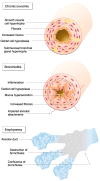The Role of Electronic Noses in Phenotyping Patients with Chronic Obstructive Pulmonary Disease
- PMID: 33187142
- PMCID: PMC7697924
- DOI: 10.3390/bios10110171
The Role of Electronic Noses in Phenotyping Patients with Chronic Obstructive Pulmonary Disease
Abstract
Chronic obstructive pulmonary disease (COPD) is a common progressive disorder of the respiratory system which is currently the third leading cause of death worldwide. Exhaled breath analysis is a non-invasive method to study lung diseases, and electronic noses have been extensively used in breath research. Studies with electronic noses have proved that the pattern of exhaled volatile organic compounds is different in COPD. More recent investigations have reported that electronic noses could potentially distinguish different endotypes (i.e., neutrophilic vs. eosinophilic) and are able to detect microorganisms in the airways responsible for exacerbations. This article will review the published literature on electronic noses and COPD and help in identifying methodological, physiological, and disease-related factors which could affect the results.
Keywords: COPD; VOCs; chronic obstructive pulmonary disease; e-nose; electronic nose; volatile organic compounds.
Conflict of interest statement
The authors declare no conflict of interest.
Figures
Similar articles
-
Electronic Nose Technology in Respiratory Diseases.Lung. 2017 Apr;195(2):157-165. doi: 10.1007/s00408-017-9987-3. Epub 2017 Feb 25. Lung. 2017. PMID: 28238110 Review.
-
Ultrafast gas chromatography coupled to electronic nose to identify volatile biomarkers in exhaled breath from chronic obstructive pulmonary disease patients: A pilot study.Biomed Chromatogr. 2019 Dec;33(12):e4684. doi: 10.1002/bmc.4684. Epub 2019 Sep 9. Biomed Chromatogr. 2019. PMID: 31423612
-
Validation of exhaled volatile organic compounds analysis using electronic nose as index of COPD severity.Int J Chron Obstruct Pulmon Dis. 2018 May 1;13:1441-1448. doi: 10.2147/COPD.S159684. eCollection 2018. Int J Chron Obstruct Pulmon Dis. 2018. PMID: 29750030 Free PMC article.
-
Identification of airway bacterial colonization by an electronic nose in Chronic Obstructive Pulmonary Disease.Respir Med. 2014 Nov;108(11):1608-14. doi: 10.1016/j.rmed.2014.09.008. Epub 2014 Sep 19. Respir Med. 2014. PMID: 25269711
-
Established methodological issues in electronic nose research: how far are we from using these instruments in clinical settings of breath analysis?J Breath Res. 2015 Jun 9;9(3):034001. doi: 10.1088/1752-7155/9/3/034001. J Breath Res. 2015. PMID: 26056127 Review.
Cited by
-
Chemical Nose-Based Non-Invasive Detection of Breast Cancer Using Exhaled Breath.Sensors (Basel). 2025 Mar 31;25(7):2210. doi: 10.3390/s25072210. Sensors (Basel). 2025. PMID: 40218723 Free PMC article.
-
Volatilome and machine learning in ischemic heart disease: Current challenges and future perspectives.World J Cardiol. 2025 Apr 26;17(4):106593. doi: 10.4330/wjc.v17.i4.106593. World J Cardiol. 2025. PMID: 40308617 Free PMC article.
-
Volatile Organic Compounds in Exhaled Breath as Fingerprints of Lung Cancer, Asthma and COPD.J Clin Med. 2020 Dec 24;10(1):32. doi: 10.3390/jcm10010032. J Clin Med. 2020. PMID: 33374433 Free PMC article. Review.
-
Application of Artificial Intelligence in Emergency Nursing of Patients with Chronic Obstructive Pulmonary Disease.Contrast Media Mol Imaging. 2021 Nov 24;2021:6423398. doi: 10.1155/2021/6423398. eCollection 2021. Contrast Media Mol Imaging. 2021. PMID: 34908913 Free PMC article. Clinical Trial.
-
Minimally invasive biomarkers for triaging lung nodules-challenges and future perspectives.Cancer Metastasis Rev. 2025 Jan 31;44(1):29. doi: 10.1007/s10555-025-10247-5. Cancer Metastasis Rev. 2025. PMID: 39888565 Free PMC article. Review.
References
-
- Vogelmeier C.F., Criner G.J., Martinez F.J., Anzueto A., Barnes P.J., Bourbeau J., Celli B.R., Chen R., Decramer M., Fabbri L.M., et al. Global Strategy for the Diagnosis, Management, and Prevention of Chronic Obstructive Lung Disease 2017 Report: GOLD Executive Summary. Eur. Respir. J. 2017;49:1700214. doi: 10.1183/13993003.00214-2017. - DOI - PubMed
-
- Pascoe S., Locantore N., Dransfield M.T., Barnes N.C., Pavord I.D. Blood eosinophil counts, exacerbations, and response to the addition of inhaled fluticasone furoate to vilanterol in patients with chronic obstructive pulmonary disease: A secondary analysis of data from two parallel randomised controlled trials. Lancet. Respir. Med. 2015;3:435–442. doi: 10.1016/S2213-2600(15)00106-X. - DOI - PubMed
Publication types
MeSH terms
Substances
LinkOut - more resources
Full Text Sources
Medical




